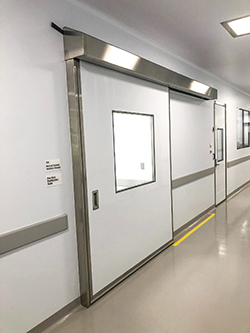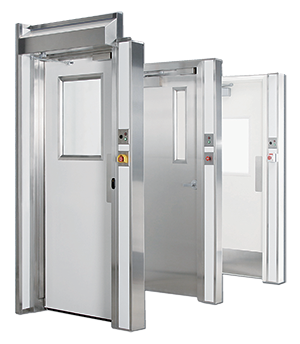For hundreds of years, manufacturers have been concerned with limiting non-essential elements in their production environments. From Swiss watchmakers who prevent dust from falling on their timepieces with bell jars to the development of high-efficiency particulate air (HEPA) filters for use in atomic energy production, technology for contamination control has come a long way.
Today, cleanrooms are essential for contamination control. Manufacturers in pharmaceutical, electronics, biopharmaceutical, medical devices, and other critical manufacturing industries, as well as researchers in specialized environments, require their cleanrooms to be simultaneously functional, flexible, economical, and practical.
 The introduction of ISO 14644-4 specifies requirements for the design and construction of cleanroom and clean air devices. This International Standard also provides direction on the basic elements of design and construction. Construction guidance is provided, including requirements for start-up and qualification. Bare-bone elements of design and construction needed to ensure continued satisfactory operations are identified through the consideration of significant factors of operation and maintenance. The regularity and relative consistency of these systems across manufacturing platforms has ushered in a new age of cleanroom design focused on all components of the room, including floors, walls, and especially doors.
The introduction of ISO 14644-4 specifies requirements for the design and construction of cleanroom and clean air devices. This International Standard also provides direction on the basic elements of design and construction. Construction guidance is provided, including requirements for start-up and qualification. Bare-bone elements of design and construction needed to ensure continued satisfactory operations are identified through the consideration of significant factors of operation and maintenance. The regularity and relative consistency of these systems across manufacturing platforms has ushered in a new age of cleanroom design focused on all components of the room, including floors, walls, and especially doors.
Requirements for door systems are not specifically covered within cleanroom standards, so project engineers and designers must carefully investigate and consider a number of issues to find the best solution. Choosing the right door system, whether it is a Class 100 or a Class 10,000 environment, may make all the difference in the effectiveness and cost-efficiency of a cleanroom. Just think about what the wrong doors can cost inexpensive downtime from cross-contamination or maintenance, lack of flexibility, or costly functional upgrades. Following are some considerations for choosing the right door system.
Air Pressure and Sealing
Keeping airborne contaminants generated by people, processes, facilities, and equipment from entering or suspending in the environment is of primary concern to cleanroom design. Because pharmaceutical cleanrooms are classified according to the particle concentration of the air, the right doors are essential to meeting the cleanliness criteria required.
To support air filter technology, maintaining appropriate room pressure and seal is of utmost importance. With airflow levels and negative pressures in the hallway between suites, particles can travel easily and threaten the quality of controlled substances manufactured at any given facility.
According to John Welp, Univ. of Wisconsin-Madison cleanroom expert and Waisman Clinical Biomanufacturing Facility manager of operations, this is exactly why performance door system design is of vital importance. “To control pre-determined air circulation rates as well as reducing airborne contamination, a cleanroom door system should contain proper sealing,” Welp says.
Cleanability
Logically, cleanroom doors are cleaned frequently. Cleanroom designers are constantly looking for doors that can maximize cleanability while standing up to chemical treatment.
A study showed today’s standard door materials deteriorate visibly over 30, 60, and 90 days when subjected to standard chemical solvents. The doors that fared best in this experiment were fiberglass doors manufactured much in the way fiberglass boats are created, using durable, seamless layers with no edges or grooves.
Cleanroom doors should be manufactured with minimal ledges, crevices, and angles. This inhibits dirt and bacteria from collecting easily and makes it easier to withstand frequent cleaning.
Surfaces should be non-shedding, non-porous, and resistant to sustaining microbial and fungal growth. The door system should also be designed to tolerate constant cleaning and sanitizing with harsh chemicals.
Some cleanroom doors are even installed without drilling into the floor. Just imagine the particulates that are collected in the crevices resulting from floor installation and bolt-fitting, and how difficult those areas are to clean. Coupled with cleaner installation, which limits additional particulates that are released into the air, doors installed without floor drilling are a better choice for cleanrooms.
Corrosion
Problems with corrosion go hand-in-hand with constant cleaning, especially with older door systems. Corrosion is a significant factor to be addressed in the cleanroom environment. It is not uncommon for old-style cleanroom and lab areas to be outfitted with metal doors. Painted steel or aluminum could shed particles. In an area that is truly pharmaceutical, where it is critical to keep doors extremely clean, metal doors do not necessarily fit these needs. Eventually, metal doors start to flake, deteriorate, and can dissolve after being exposed to toxic and severe cleaners.
Perfectly seamless door solutions are available with fiberglass, which provide maximum corrosion protection with a fully enclosed panel. Stainless steel edge capping on fiberglass doors gives the edges additional protection from the common impacts seen in these facilities. A door panel that is completely sealed provides superior corrosion resistance and wash-down capabilities.
Corrosion is not only a lurking problem on the door’s surface but can also affect the door’s frames. While galvanized or painted frames are a less expensive option, they corrode. Stainless steel frames offer longevity and durability from harsh chemicals.
Flexibility and Security
Besides the cleanability and durability factors, cleanroom doors should offer various options for flexibility to fit personnel’s needs as well as process requirements. Having flexible door systems enables project engineers to outfit cleanrooms with doors that feature vision panels, touchless activation devices, magnetic locks, and interlocking systems.
enables project engineers to outfit cleanrooms with doors that feature vision panels, touchless activation devices, magnetic locks, and interlocking systems.
A good cleanroom door system should be able to support the use of vision panels for seeing obstacles before entrance. Vision panels are also beneficial for supervising personnel, monitoring processes, and maximizing natural light.
When designing a cleanroom, it is critical to get all information upfront and anticipate any needs that may present themselves in the future. Adequate planning will help facilities avoid adding functions and retrofitting in the future, saving dollars in the long run.
Doors should also be designed to implement card key access, to fit owner-specified security system requirements, and to incorporate door interlock systems. Interlocks sometimes referred to as “airlocks,” are not uncommon, especially in personnel entrances and exits, gowning and de-gowning areas, and material transfer airlocks in cleanroom environments. The functional concept of the interlock is to prevent the two doors from being open at the same time, thus preventing air infiltration from one space directly to the other. This is typically done in cleanroom environments to prevent outside contaminated air from entering the process areas.
Efficiency
Ultimately cleanroom design gravitates toward greater efficiency and cost savings.
Practical cleanroom design minimizes HVAC requirements, reduces cleaning and maintenance costs, and withstands the conditions in which they function. Choosing the door system to make the cleanroom environment more efficient and more profitable is the main goal of engineers and managers.
By investigating cleanroom door products with an eye toward air seal, cleanability, corrosion, flexibility, and security, designers can provide increased returns over the life of their doors. Experts recommend strong fiberglass construction, with few or no crevices or angles. In addition, the foresight to install doors that can be improved with vision panels, touchless actuators, interlocks, and other features will save heavy replacement and upgrade costs.
In short, cleanrooms should be developed with efficient, durable door systems, which provide easy access, and maximum functionality to increase productivity while maintaining controlled conditions. There are plenty of vendors in the market. Make sure to look for a company with experience in the marketplace and proven technology and performance. For more information contact us today!
